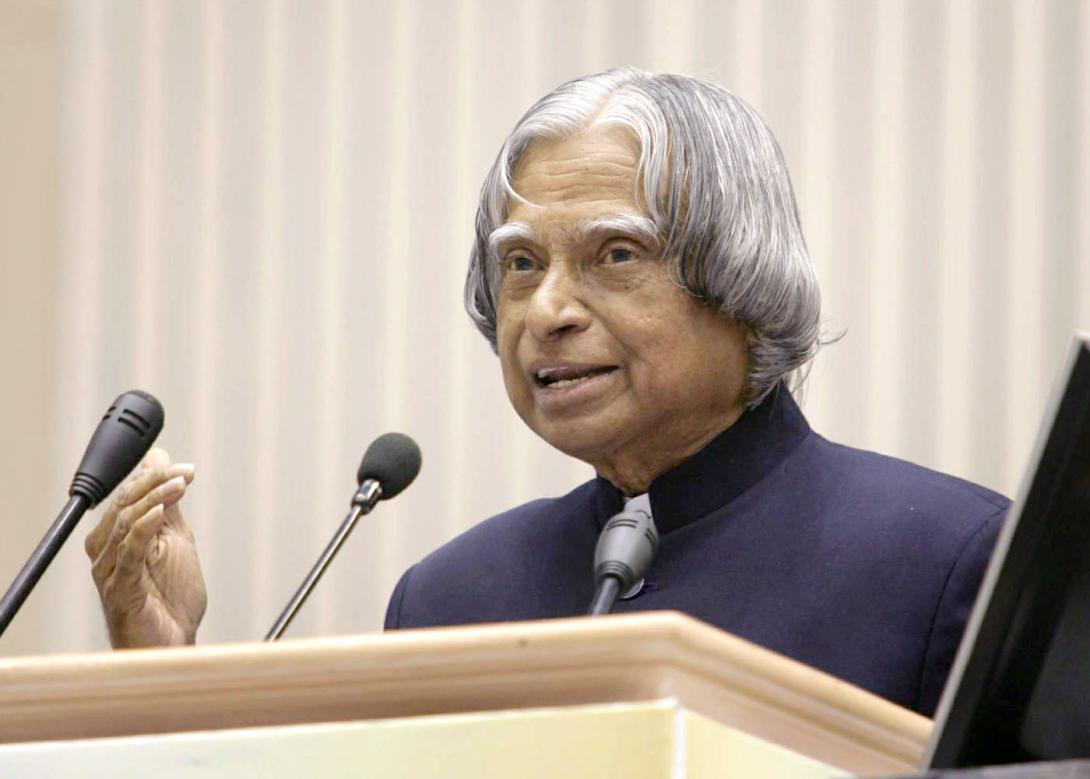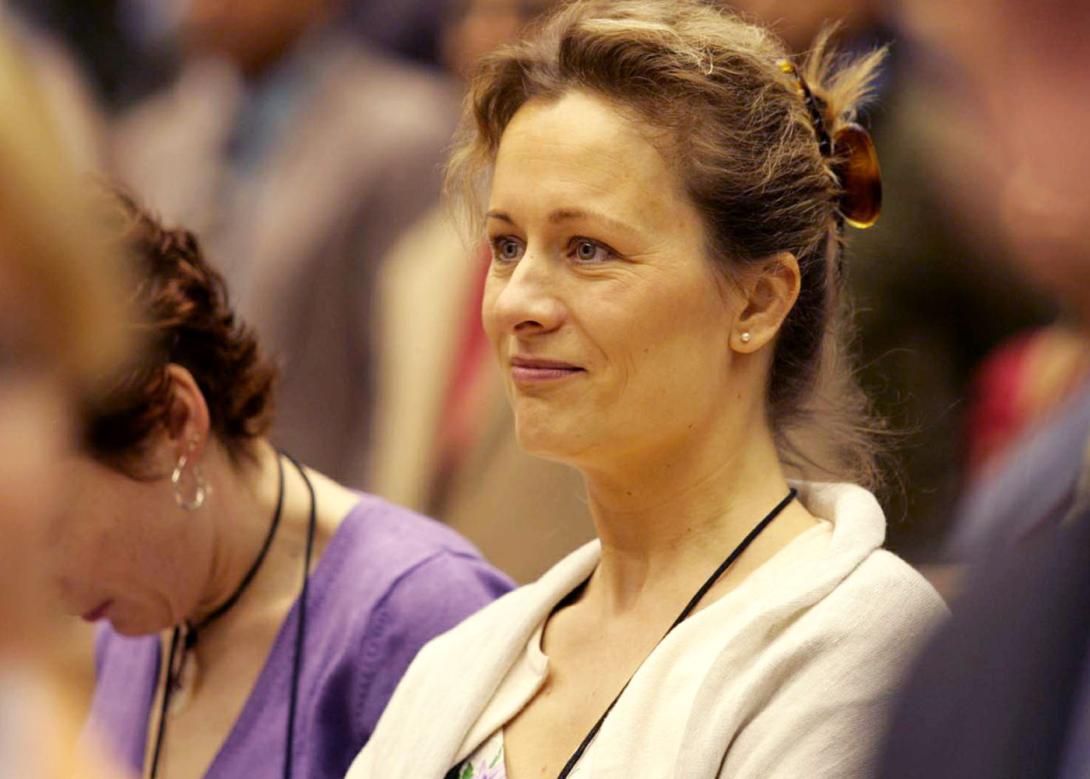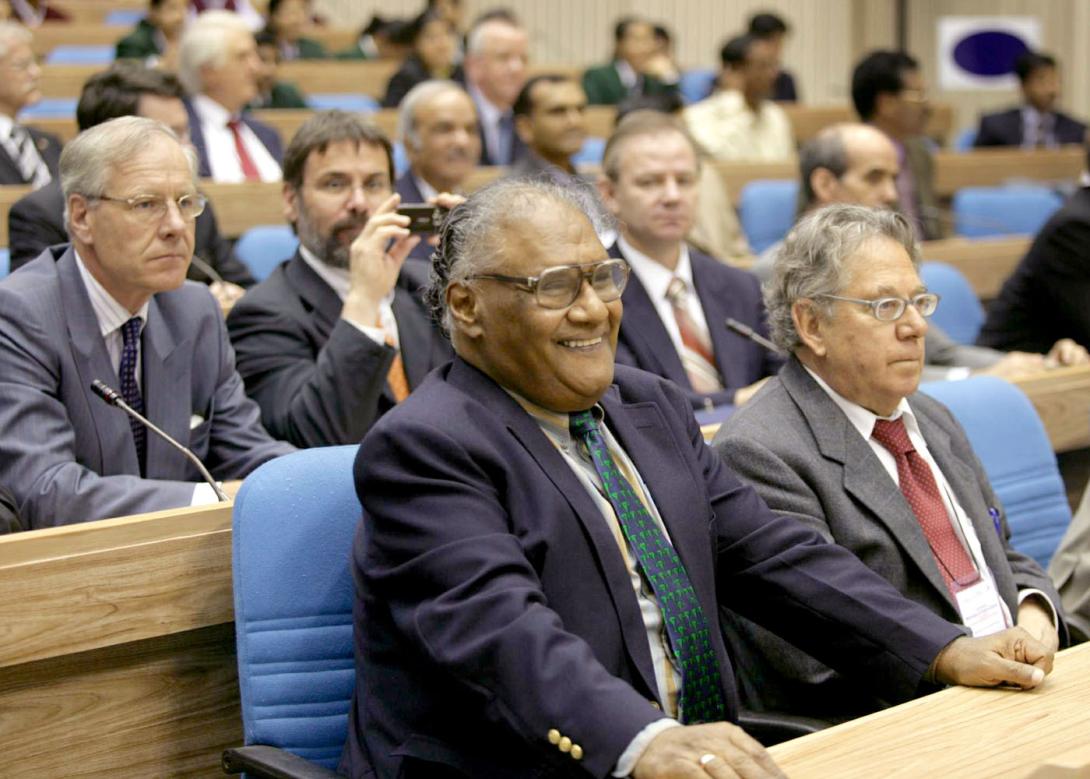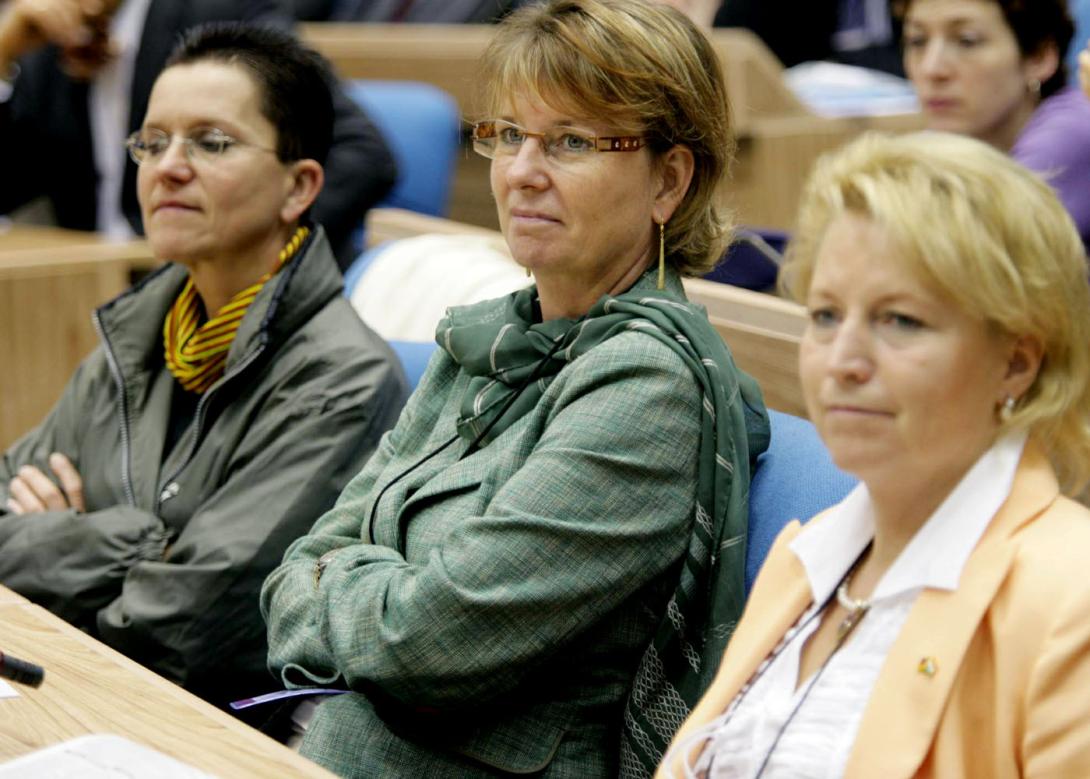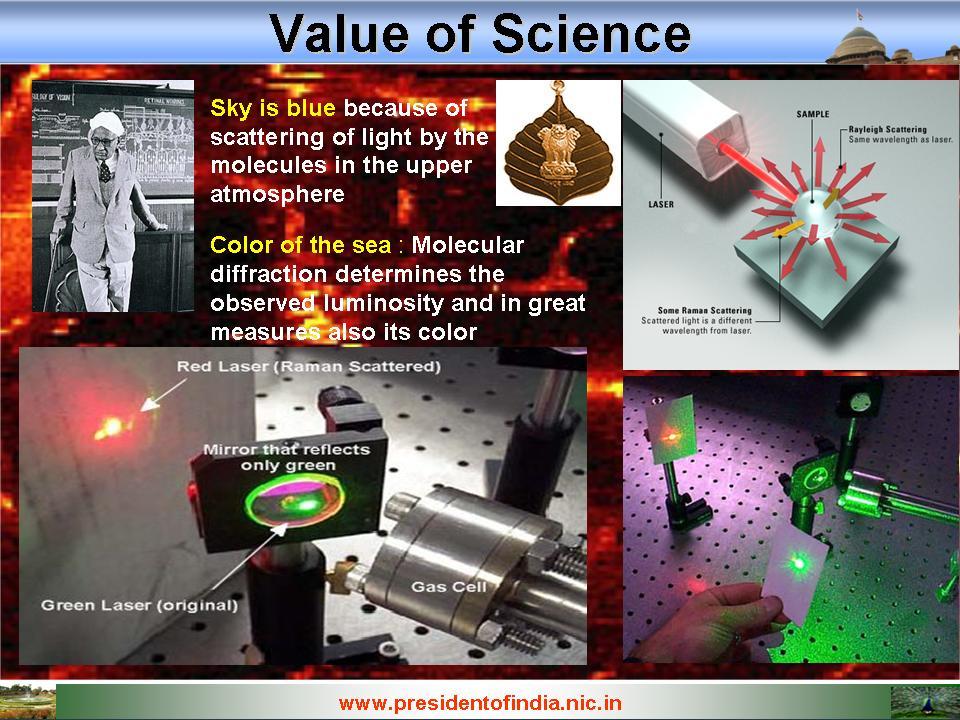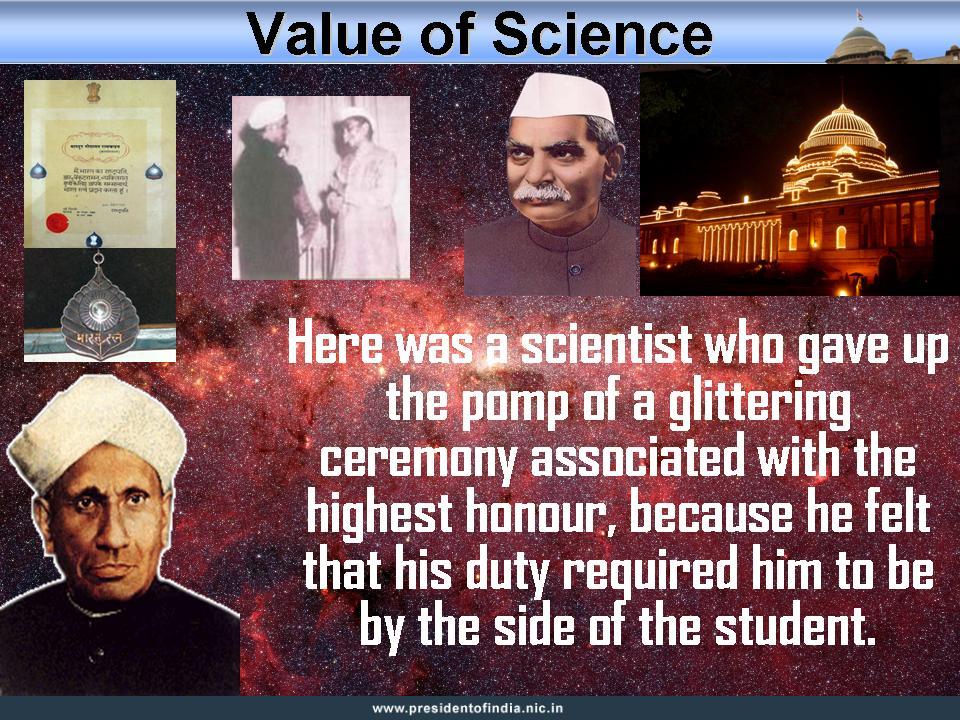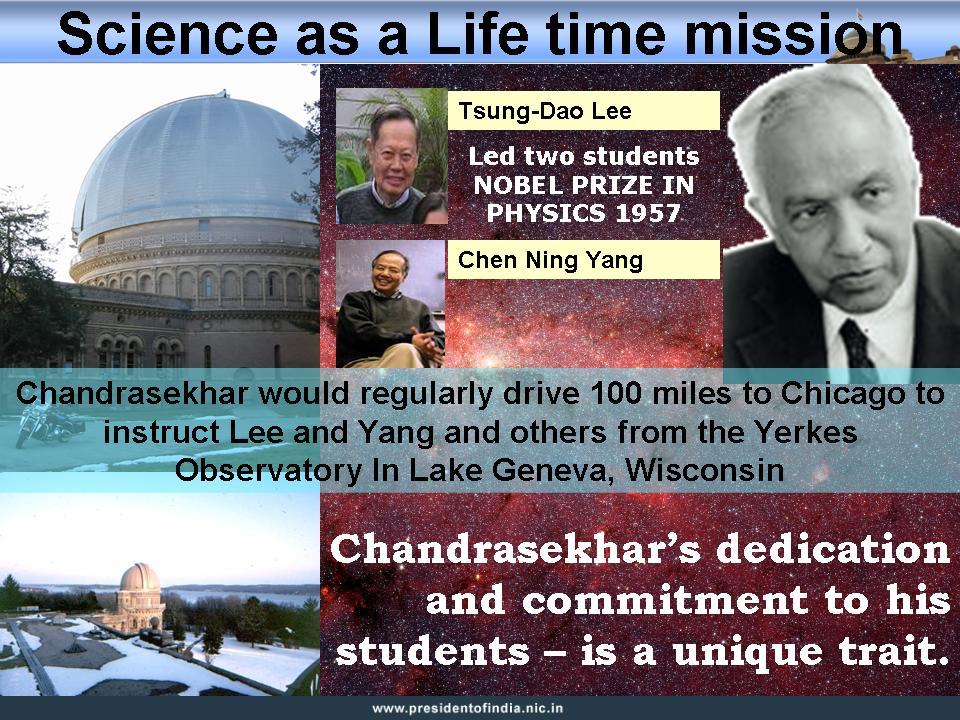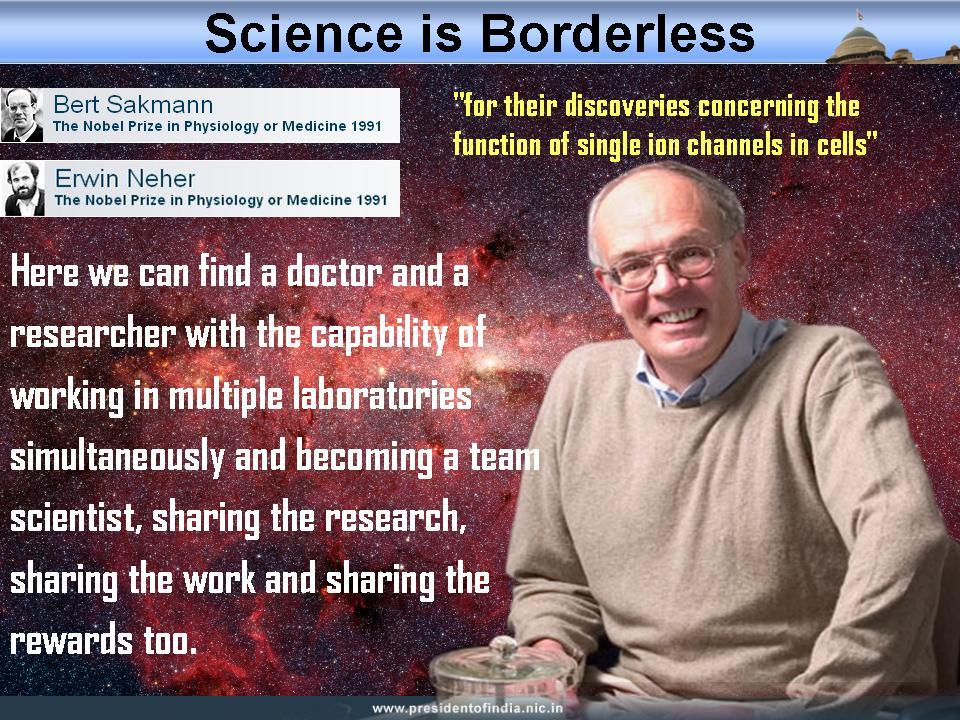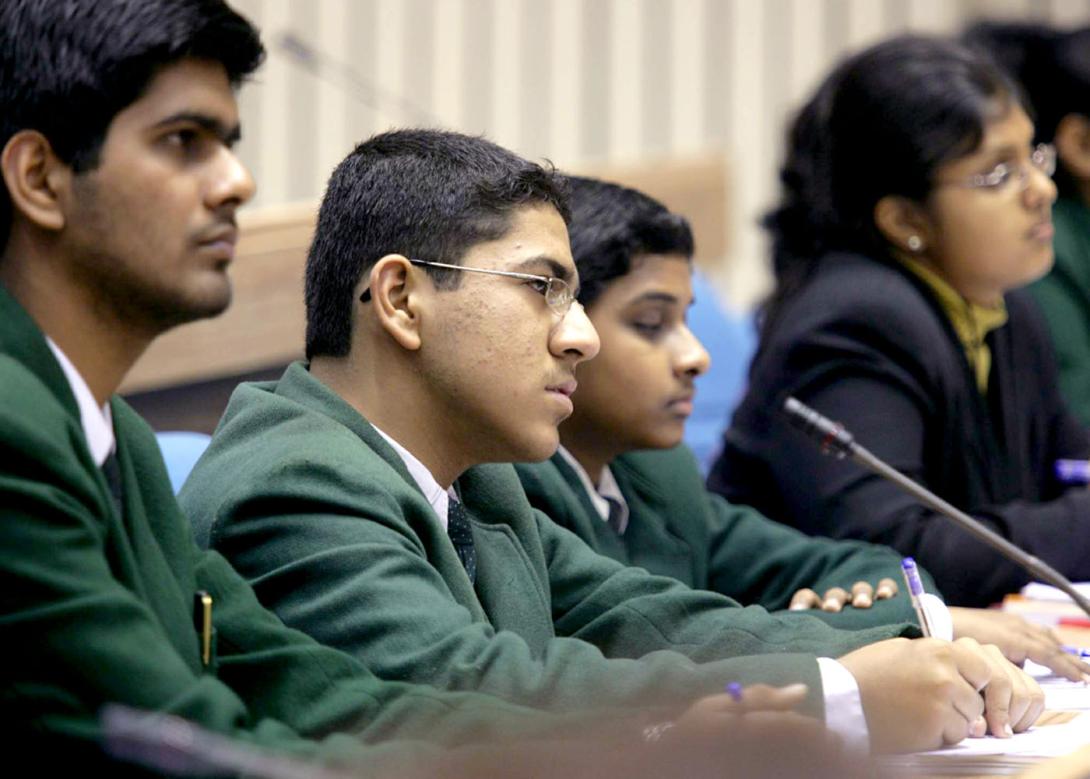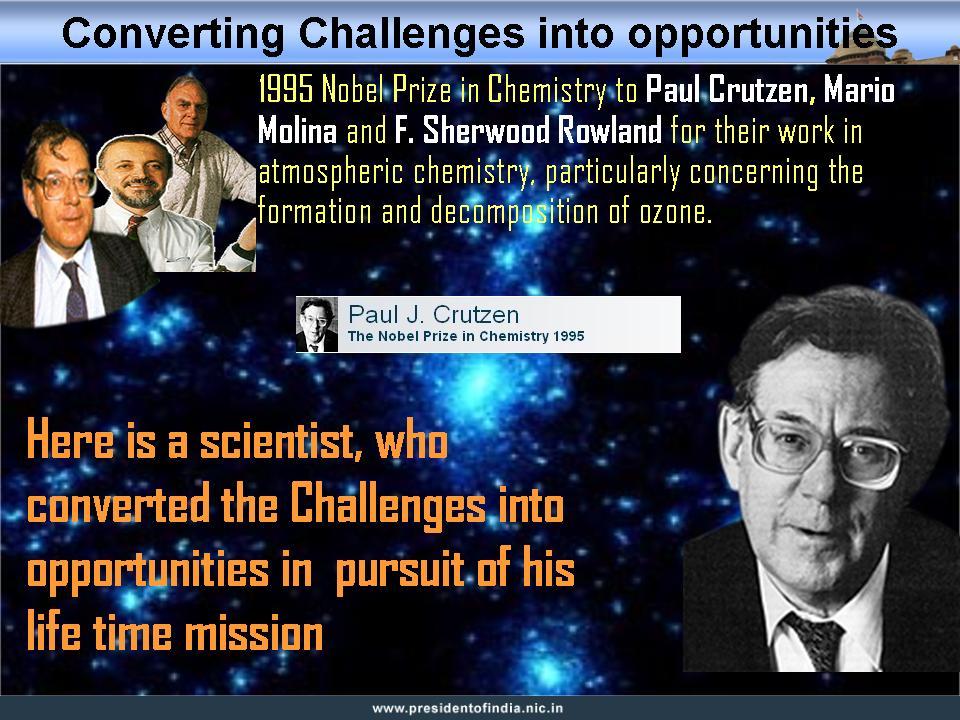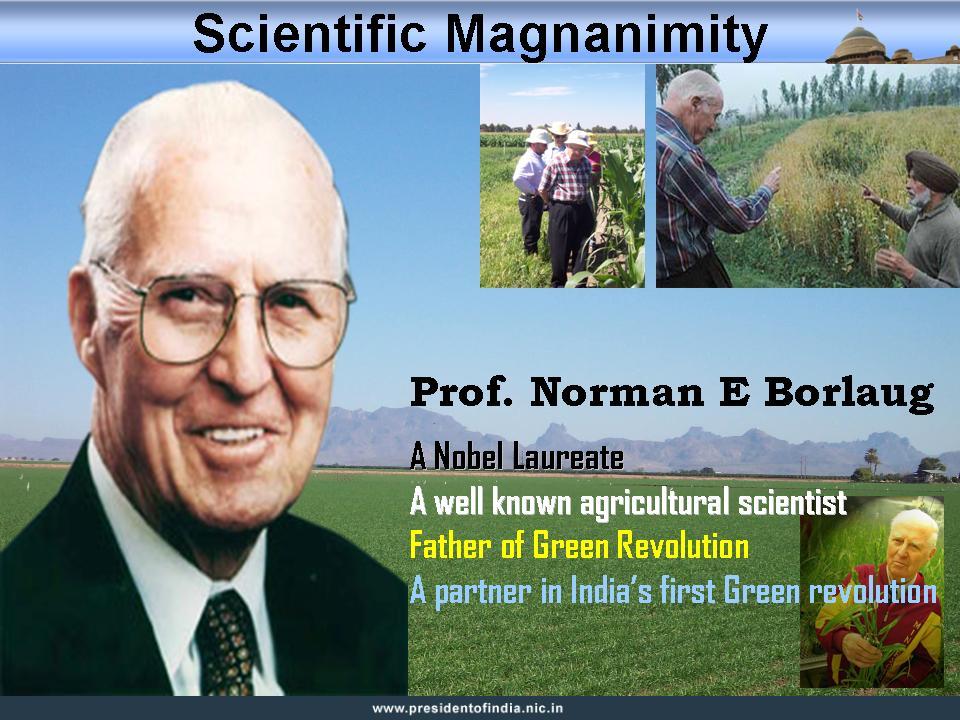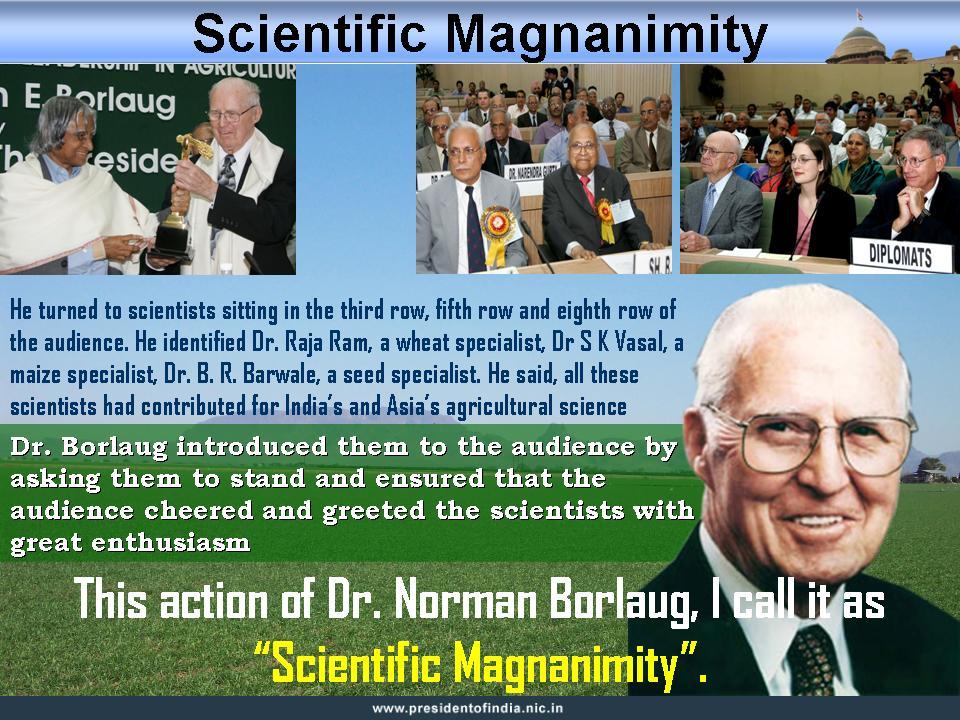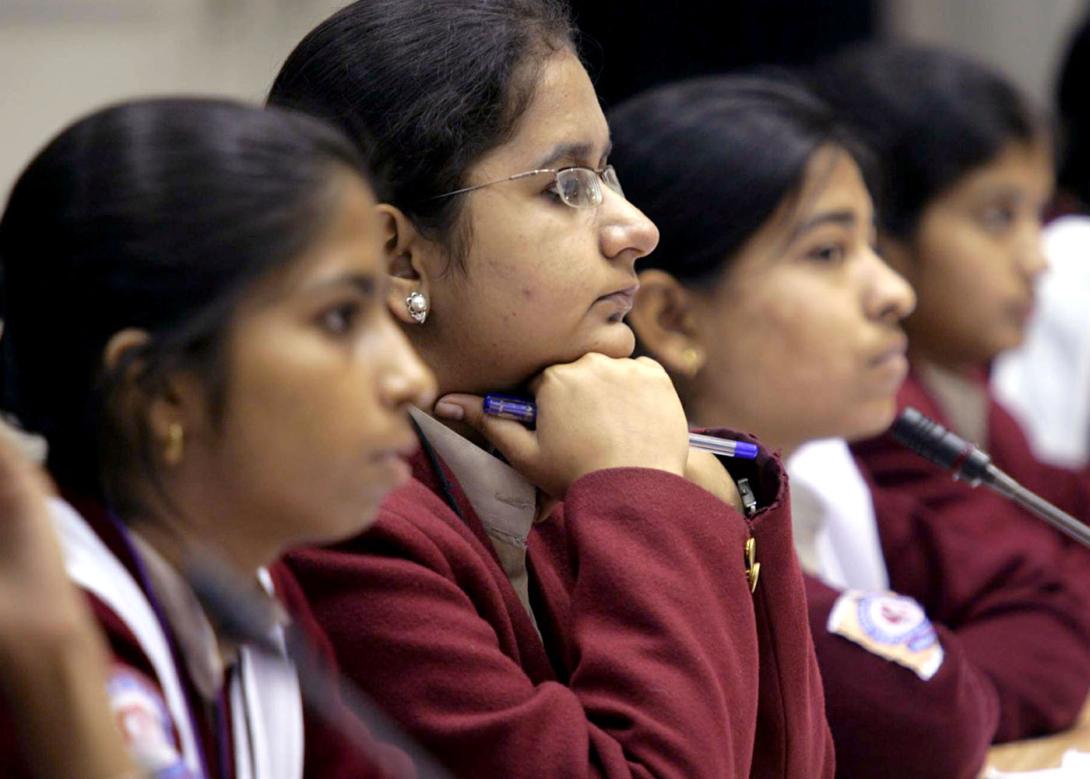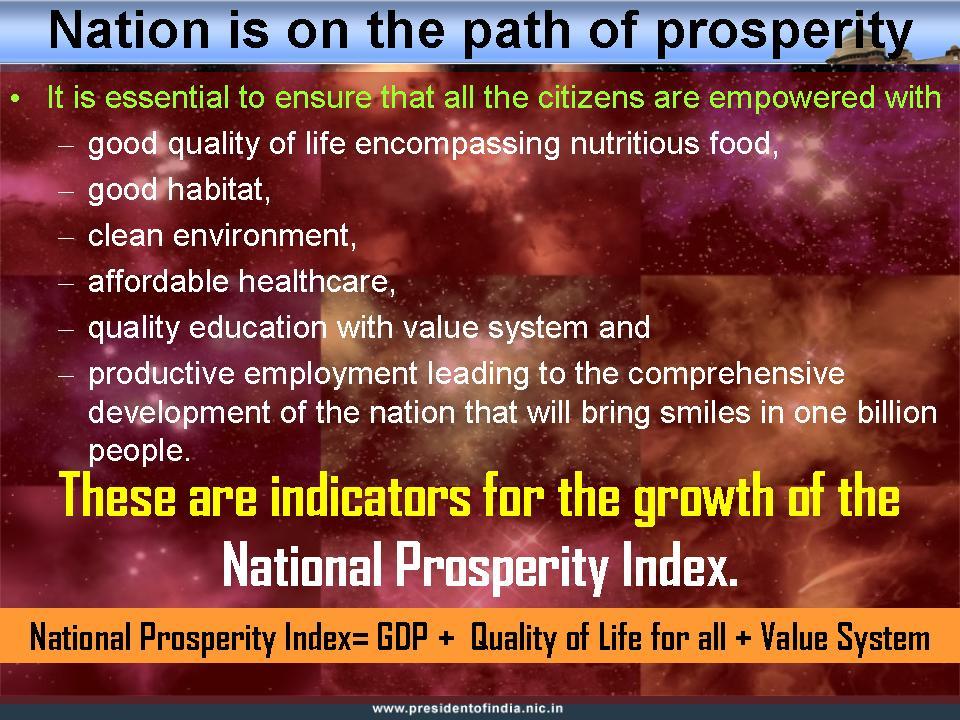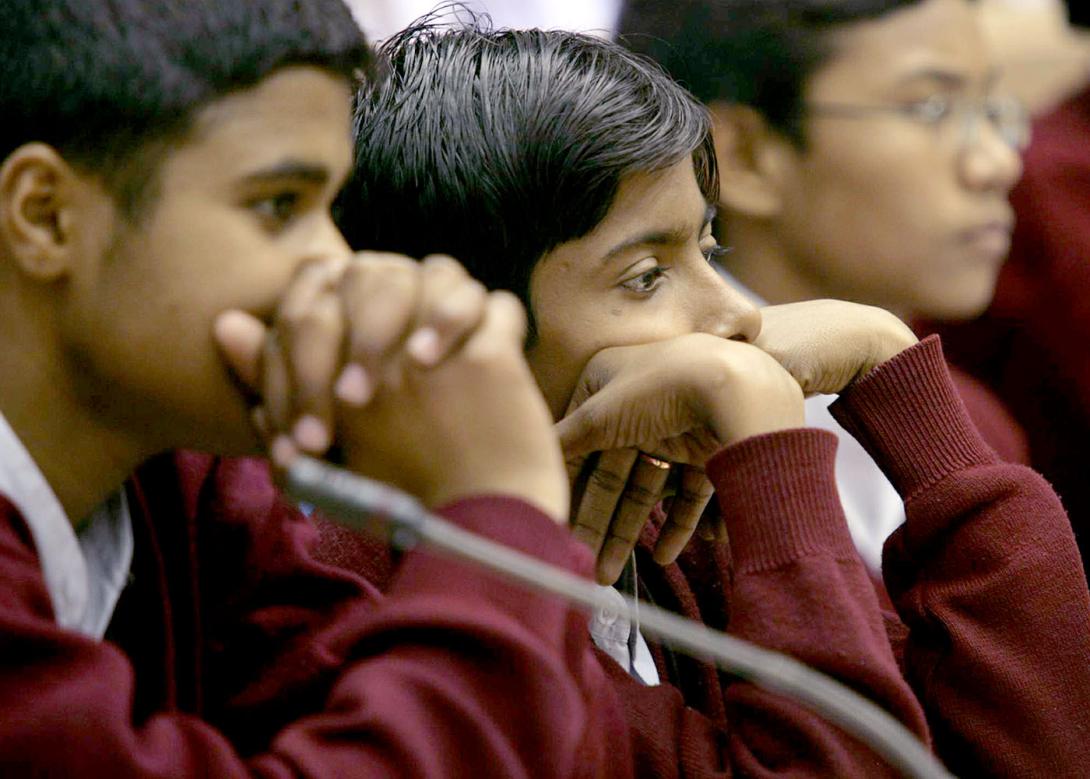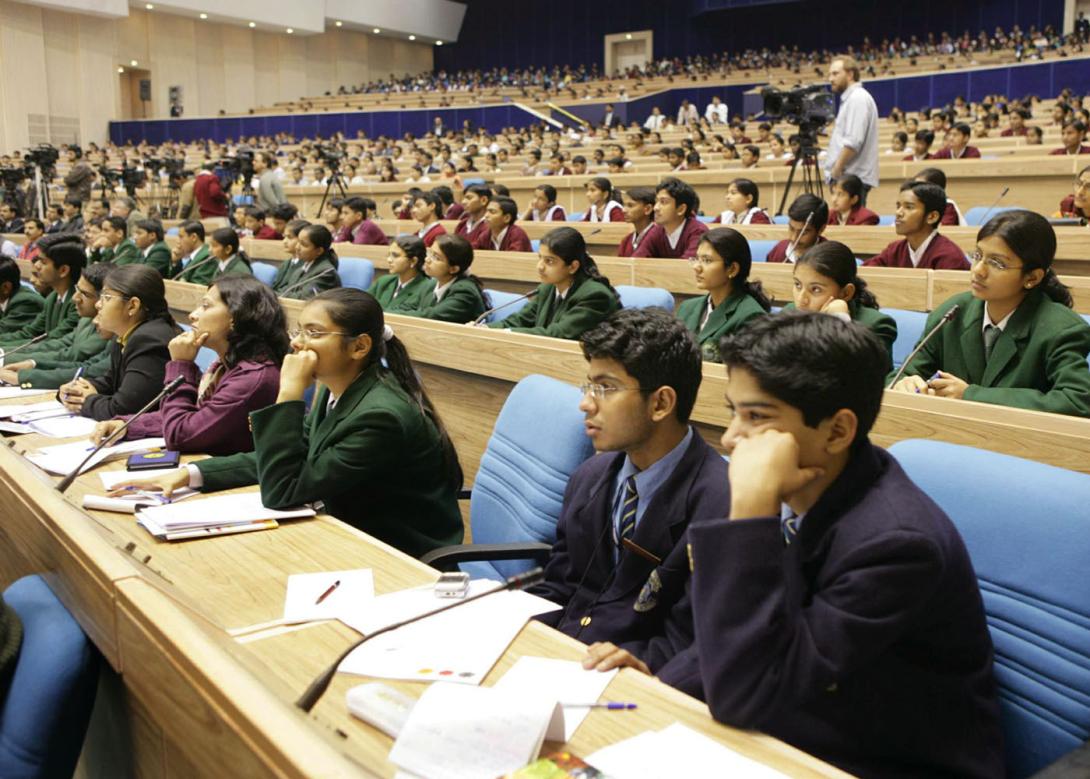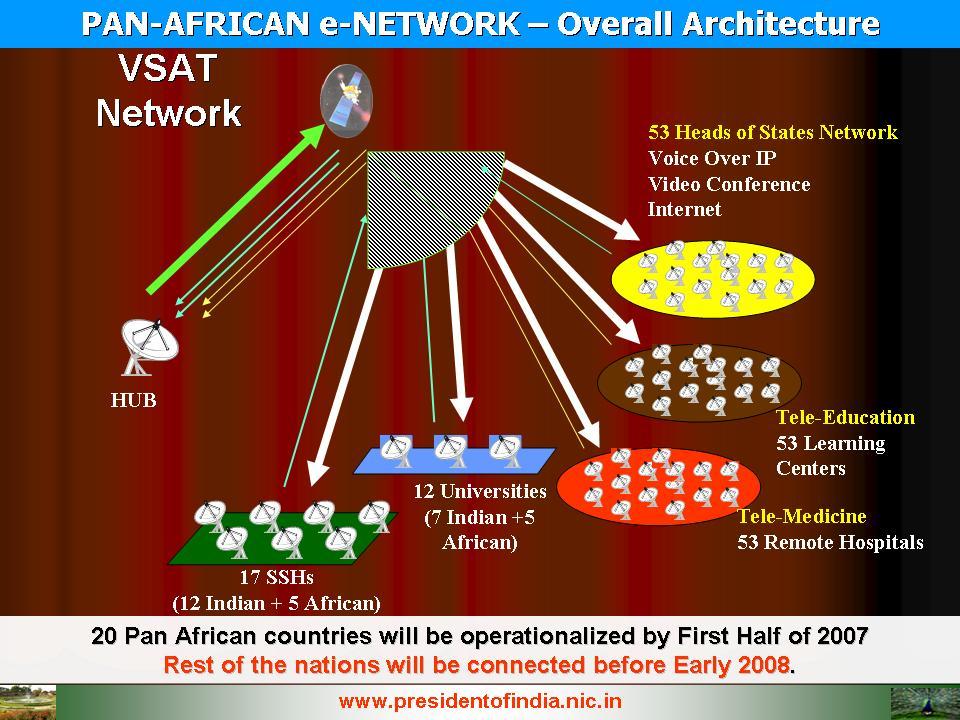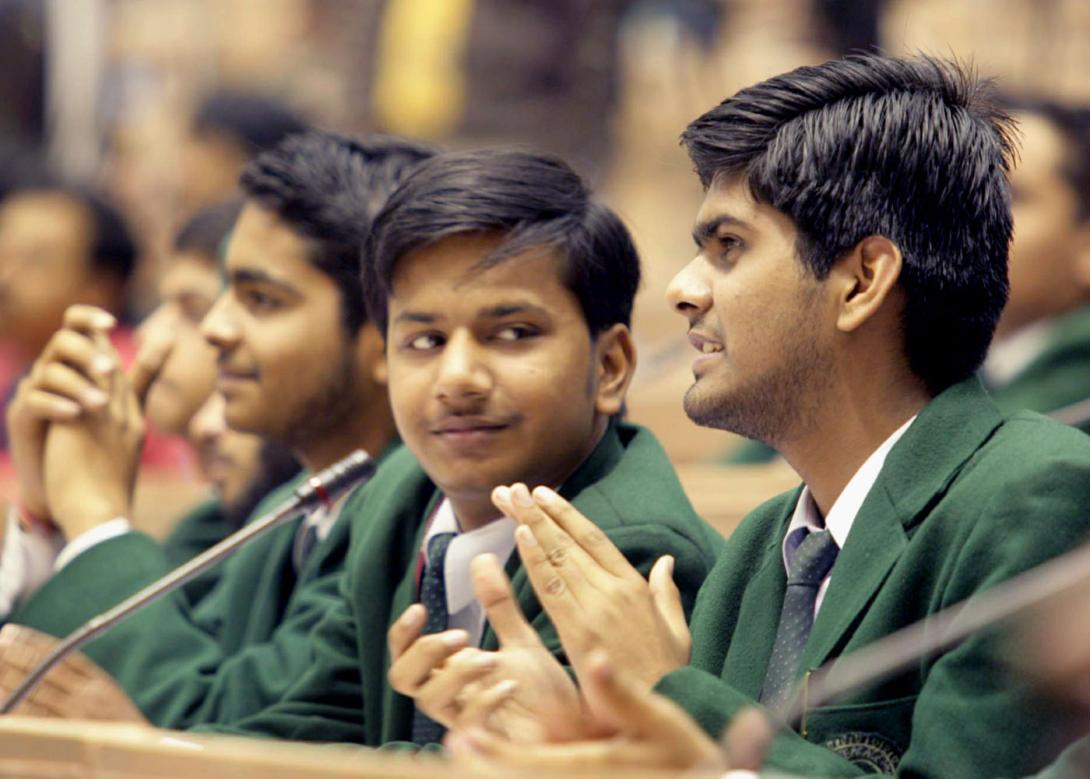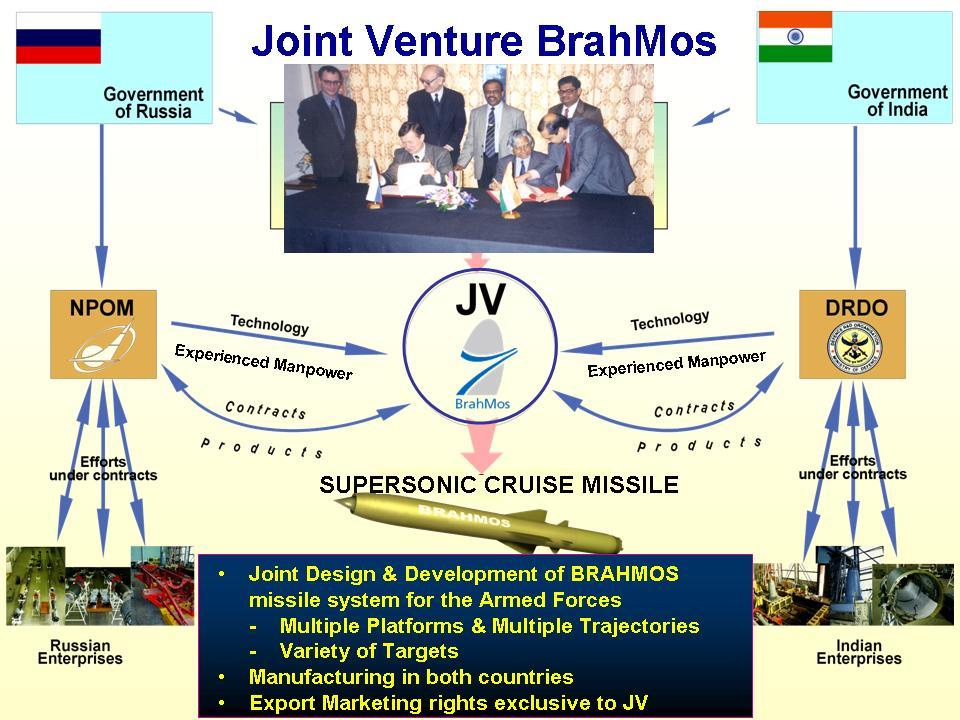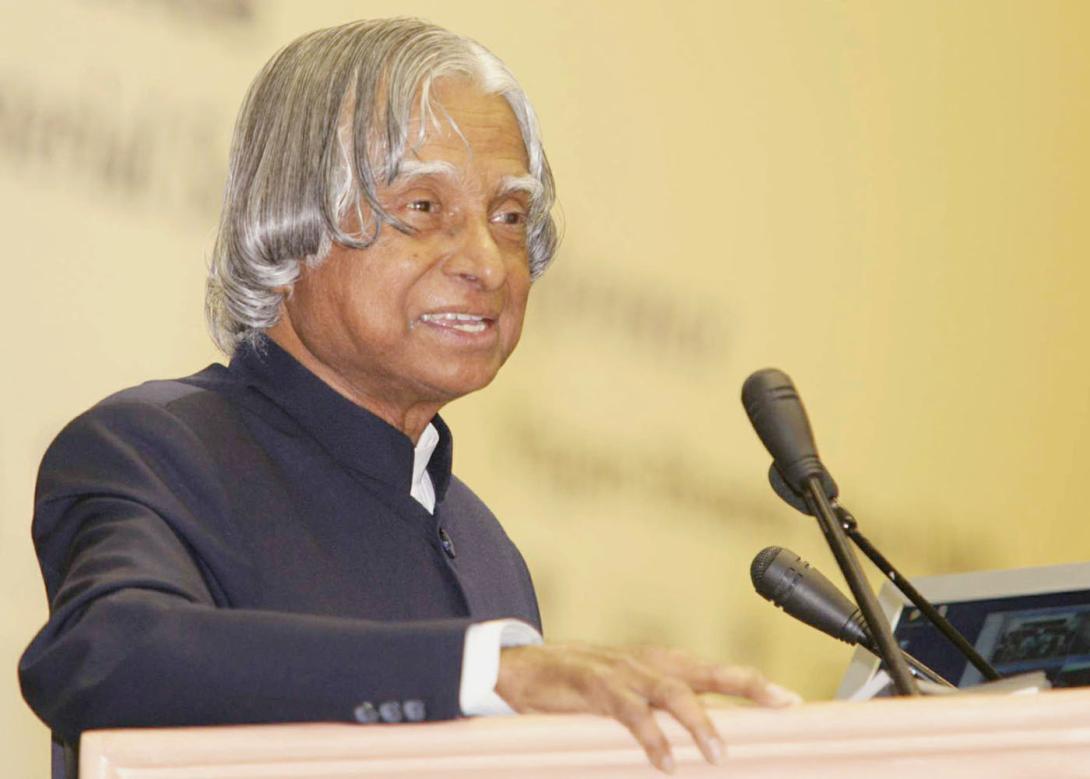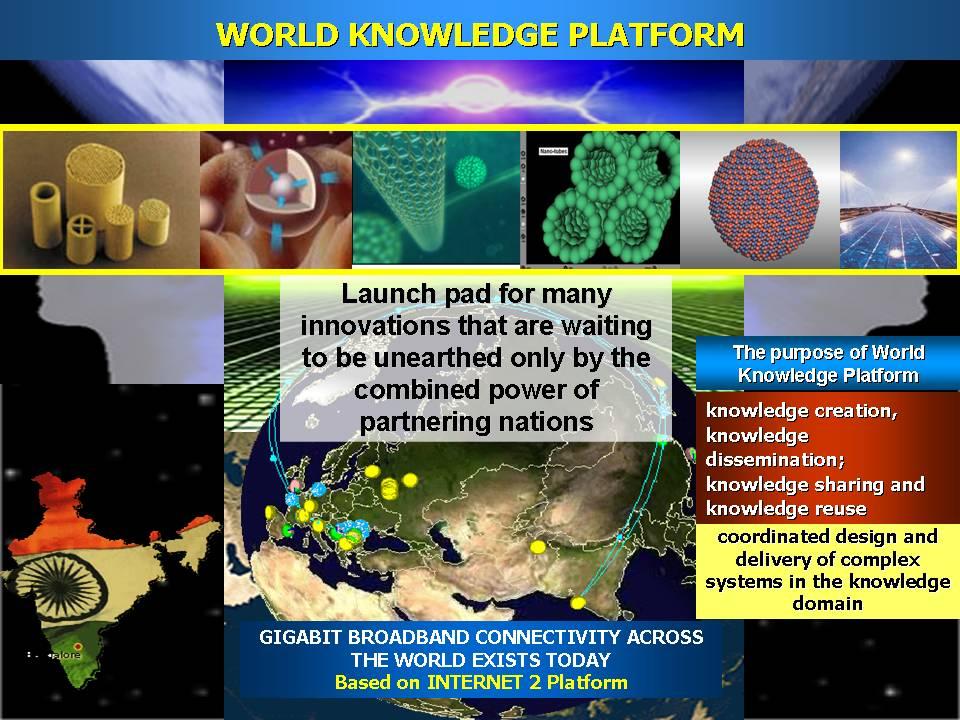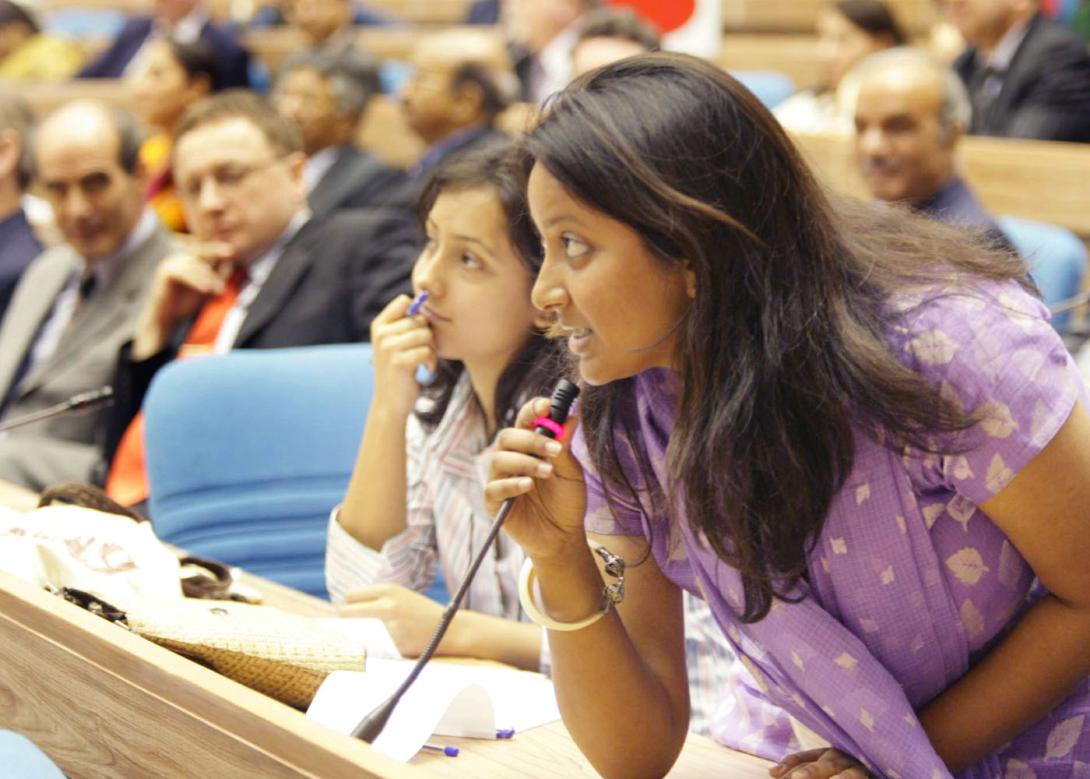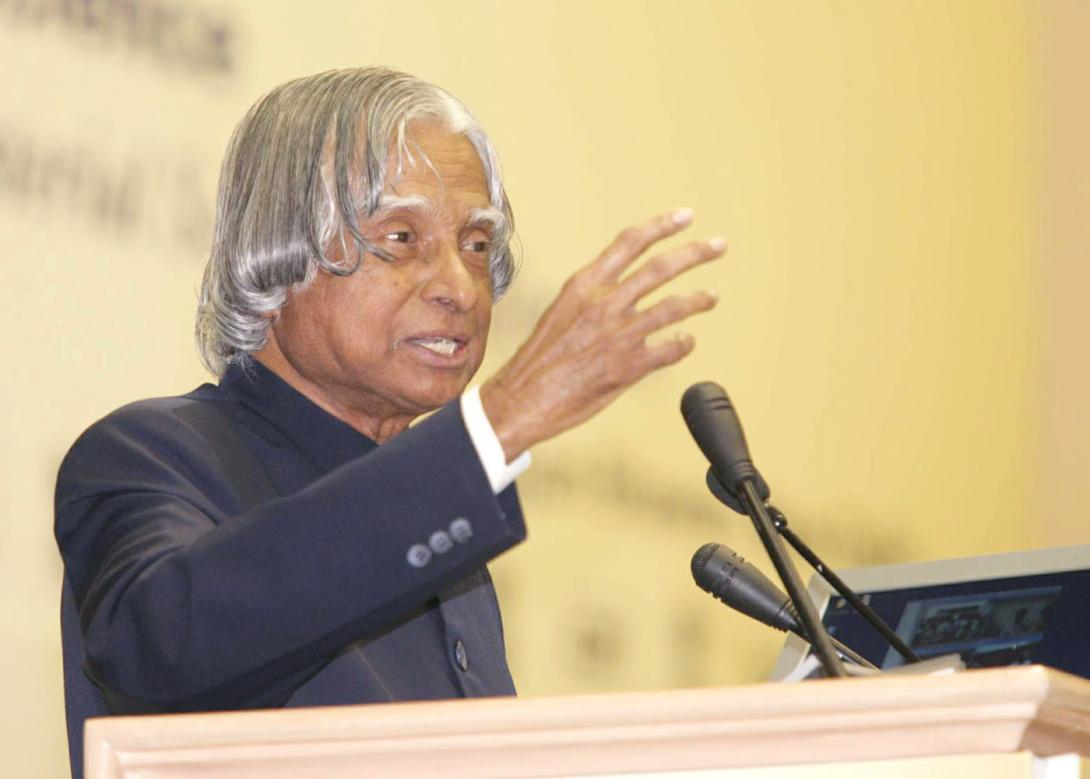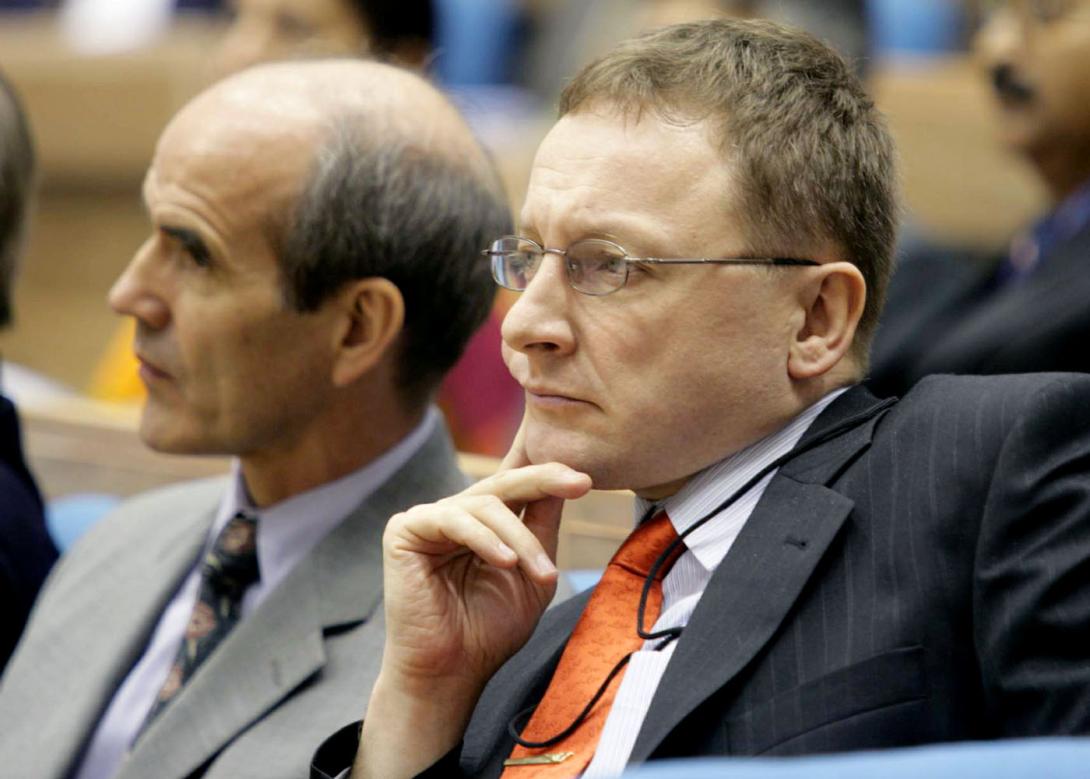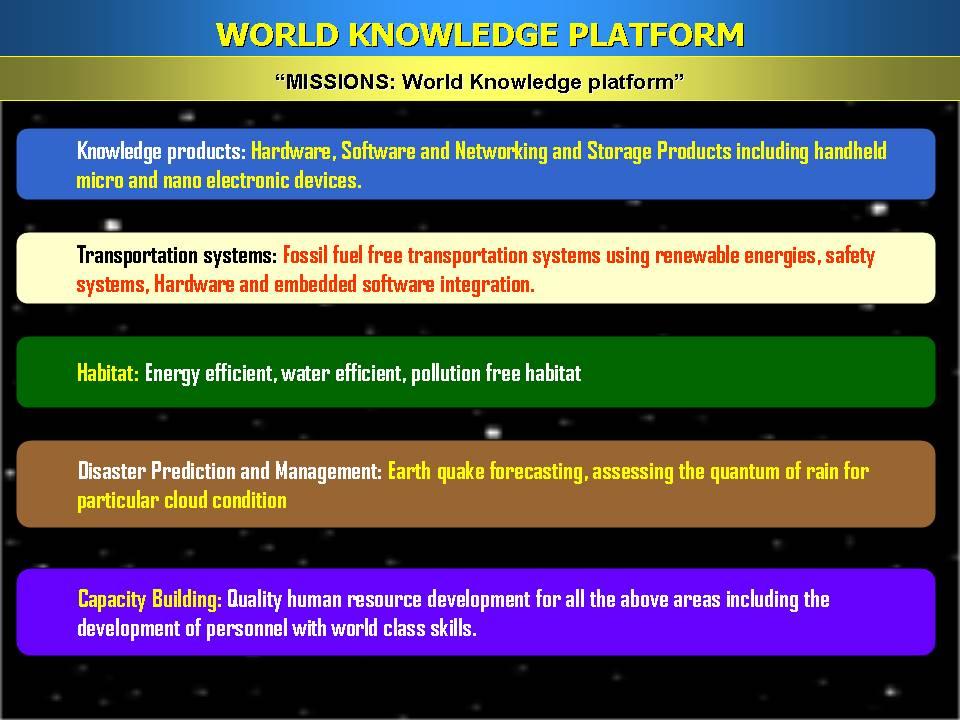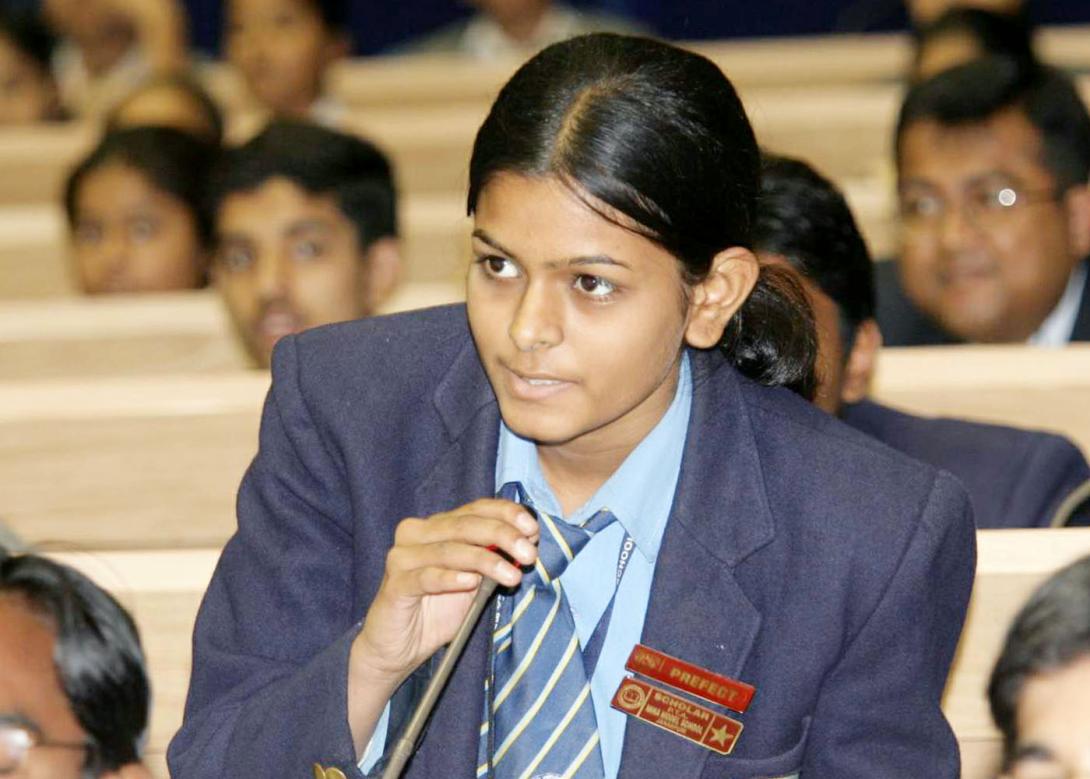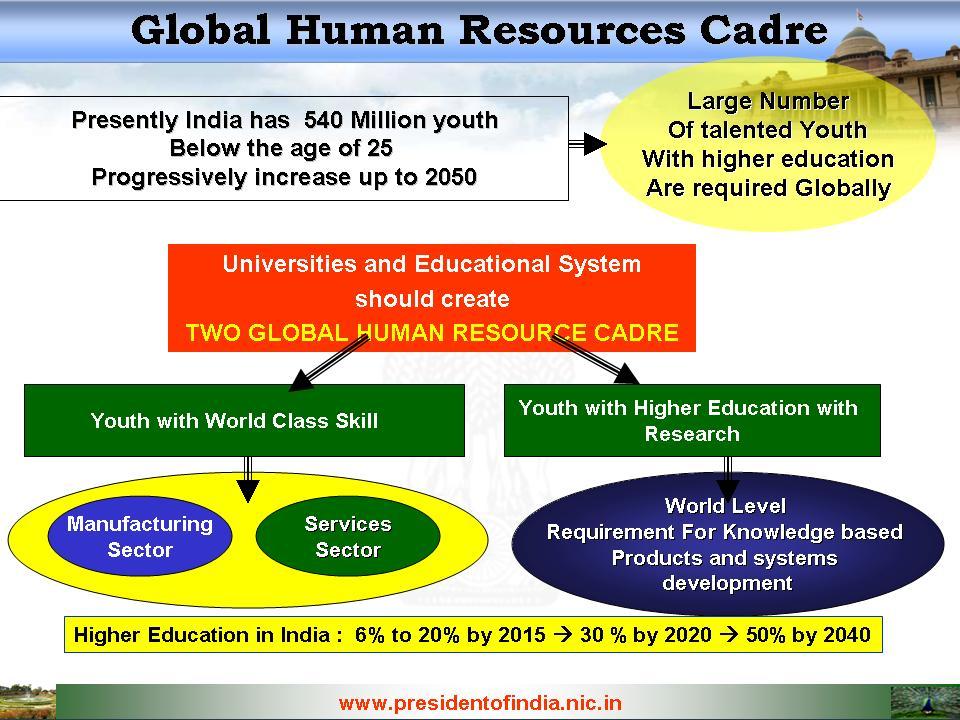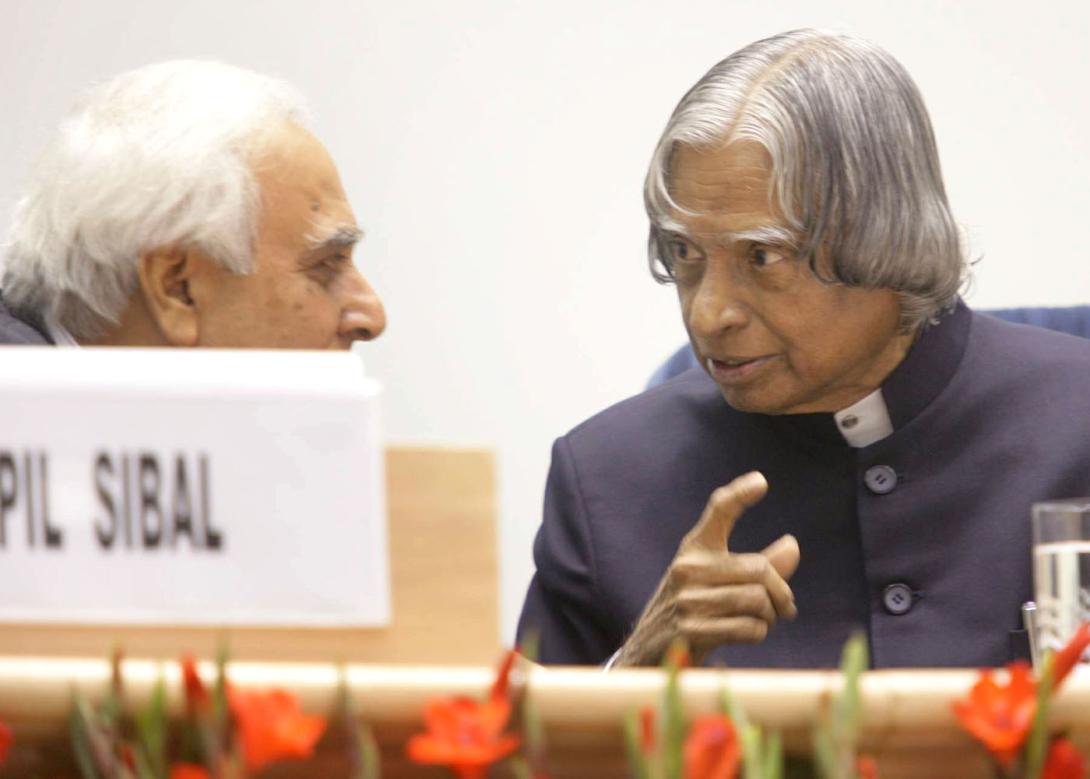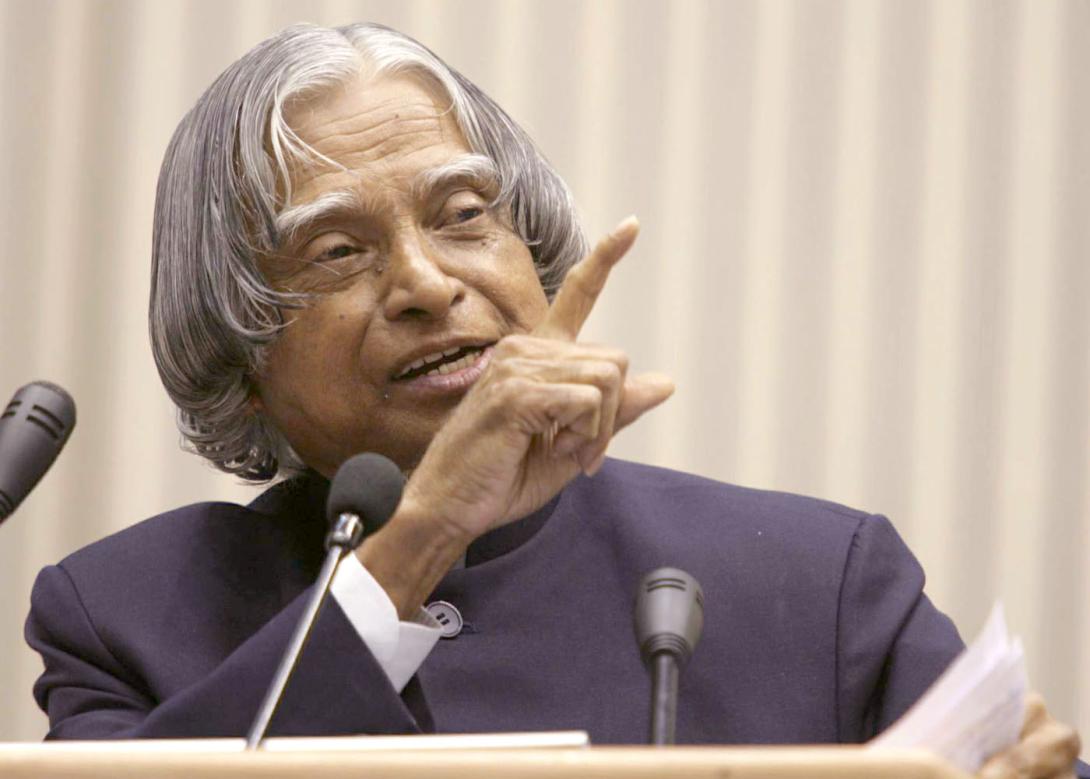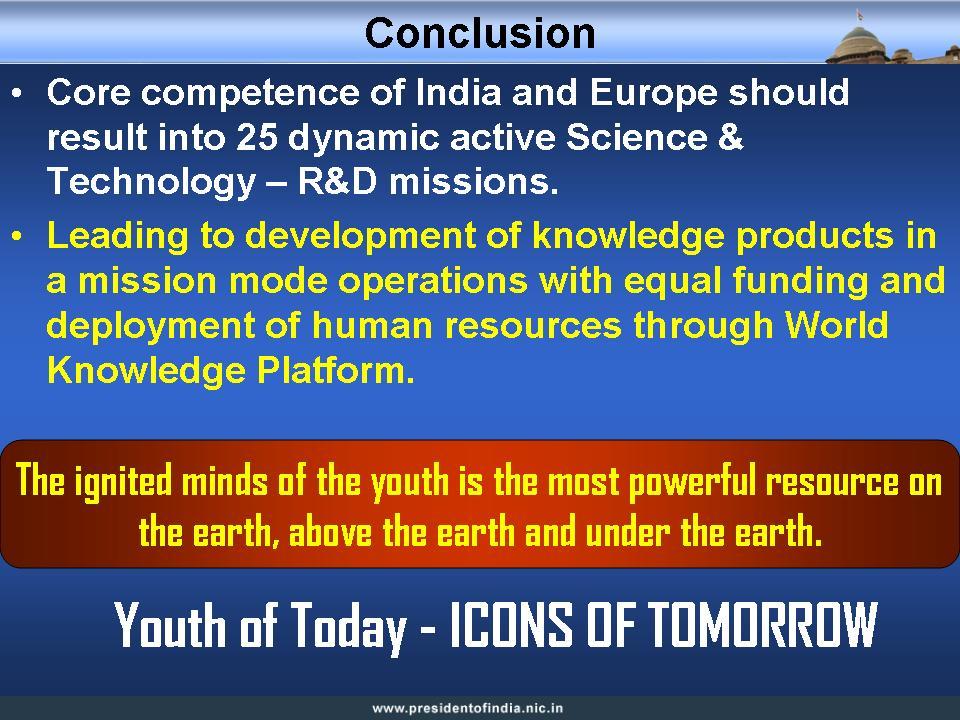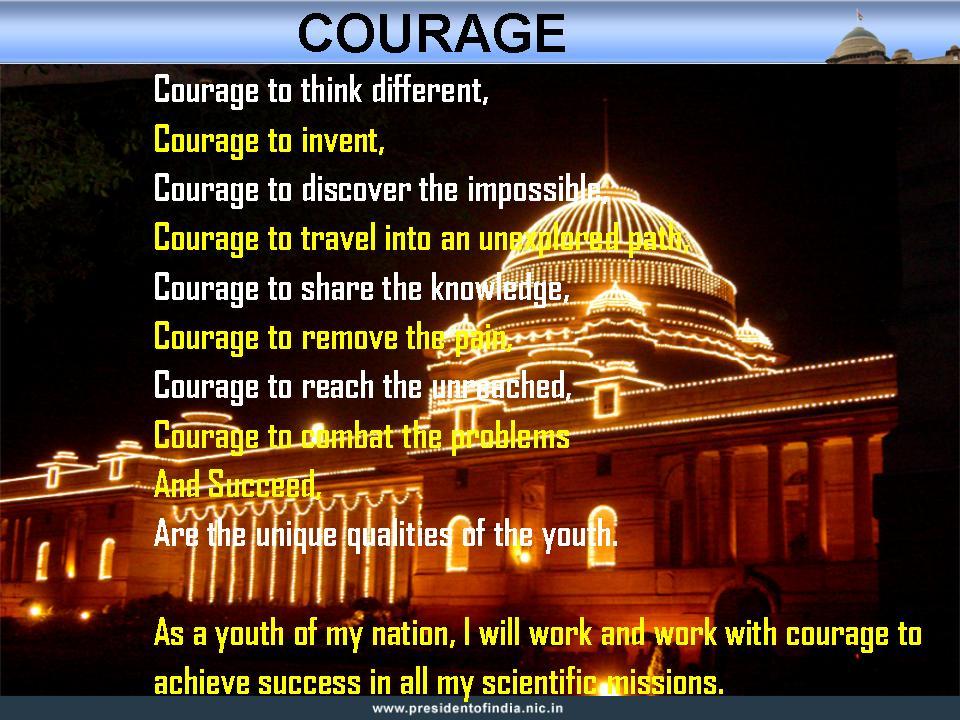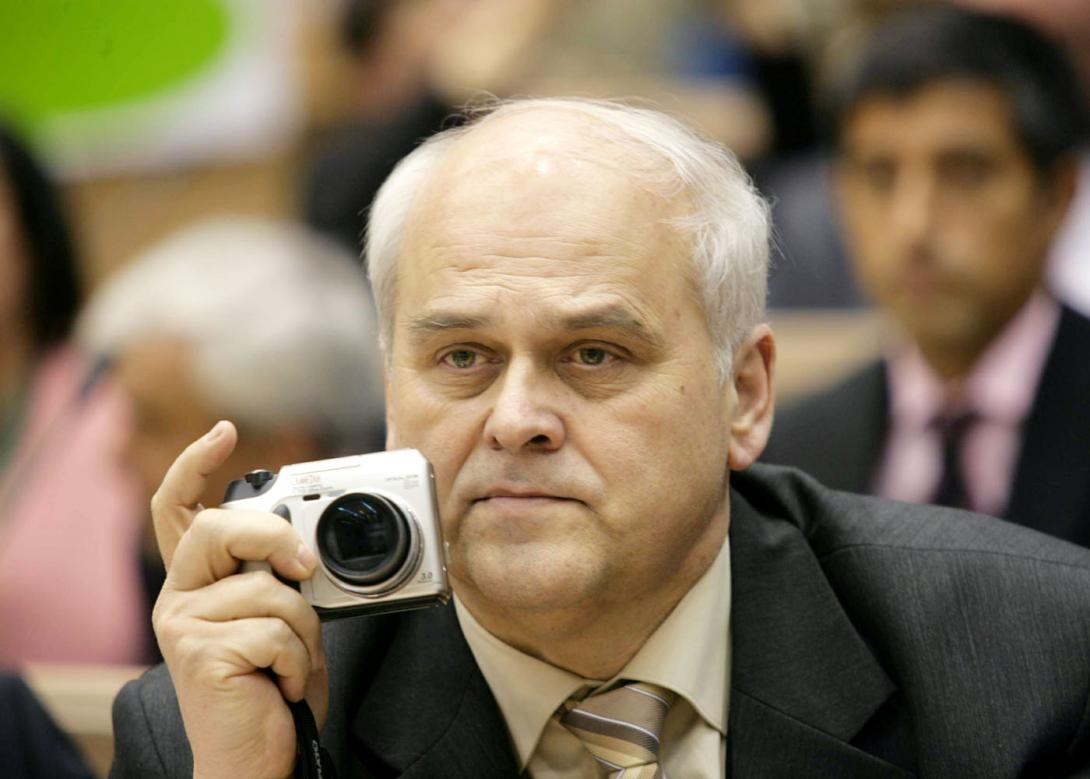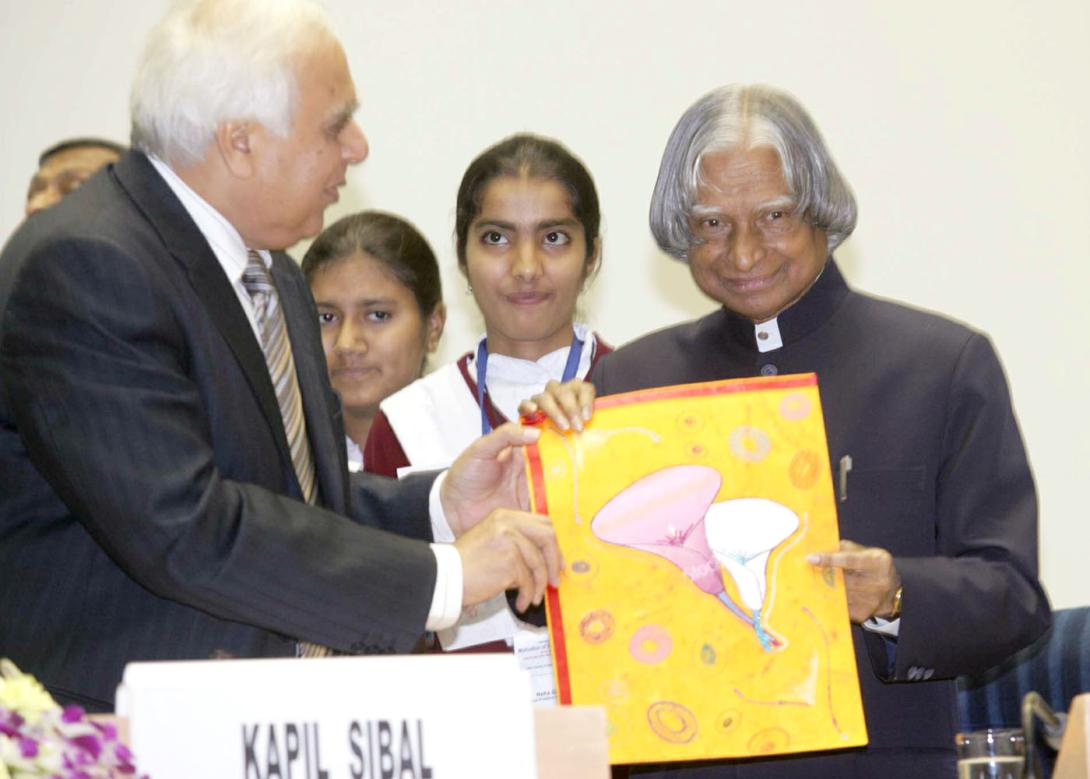Interaction Meet of Eu and Indian Science Icons With Indian Students at the India-eu Ministerial Science Conference, New Delhi
New Delhi : 08-02-2007
Ignited minds create World Knowledge Platform "Past meets the present and creates the future"
Dear friends, I am happy to interact with the young research scholars and the budding school students amidst the icons of science from European Union and India. My greetings to the esteemed dignitaries from India, EU; scientists, researchers, industrialists, policy makers and students. Europe and India both had a dynamic past. Europe had war and battle for hundreds of years and saw even two world wars. Presently, a beautiful thing has happened, so many nations have come together to form a European Union with a single focus of economic development towards promoting people?s prosperity irrespective of multiple culture and multiple language. Of course as you all are aware friends, India was ruled by many kingdoms till 1947. Since independence six decades back, India, the largest democracy in the world has made significant strides in multiple fronts such as socio-economic as well as scientific fields. With the past heritage and culture of many great thinkers and scientist contributing to the development, EU and India can combine its core strength for the mutual benefit of the both the societies. Science and Technology can play a major role in this endeavour.
In this context, I was thinking what thoughts I can share with this important audience. I would like to discuss about, what type of India today?s youth dream to live? What type of world and what type of planet earth they would like to have? The challenges before the scientific community are: Clean water, Energy Independence, Good Habitation, Pollution free atmosphere and Health for all leading to a peaceful, happy and prosperous planet.
Science is the foundation for societal transformation
Most important ingredient for realizing such a society is the ignited minds of the youth using science and technology as a powerful tool. I realize Science is linked to technology through applications. Technology is linked to economy and environment. Economy and environment are linked to technology, which promotes prosperity to the society. When I see the galaxy of great minds on the dais and off the dais including the youth in front of me, Dear young friends, I would like to share the uniqueness of five great minds, all of them Nobel Laureates, each one having unique traits which symbolize Value of Science; Science as a Life time mission; Science is Borderless; Science is about coverting challenges into opportunities and Scientific Magnanimity.
Now let me ask you one question. Young friends, how many of you aspire to become Nobel Laureates? Research Scholars, please lift your hands, Students please lift your hands. I am glad to get good response.
Let me now talk to you about the five great minds having those traits, which I just mentioned. Friends, if you acquire any of one of them or few of them or all of the traits, you will be heading towards becoming a Nobel Laureate or you will make a difference to our Planet. Let us go into details.
The traits of Nobel minds
Value to Science: Since I am in the midst of Scientists, Technologists, research scholars and students, I thought of sharing with you an incident about Sir CV Raman ?a Nobel Laureate in Physics for discovering Raman Effect. Raman gives the view that the color of sky is blue due to molecular diffraction which determines the observed luminosity and in great measures also its color. This led to the birth of the Raman Effect. Raman was in the first batch of Bharat Ratna Award winners. The award ceremony was to take place in the last week of January, soon after the Republic Day celebrations of 1954. The then President Dr. Rajendra Prasad wrote to Raman inviting him to be the personal guest in the Rashtrapati Bhavan, when Raman came to Delhi for the award ceremony. Sir CV Raman wrote a polite letter, regretting his inability to go. Raman had a noble reason for his inability to attend the investiture ceremony. He explained to the President that he was guiding a Ph.D. student and that thesis was positively due by the last day of January. The student was valiantly trying to wrap it all up and Raman felt, he had to be by the side of the research student, see that the thesis was finished, sign the thesis as the guide and then have it submitted. Here was a scientist who gave up the pomp of a glittering ceremony associated with the highest honour, because he felt that his duty required him to be by the side of the student. It is this unique trait of giving value to science that builds science. Next, let me highlight how science becomes a life time mission for Chandrasekhar Subramanyan.
Science as a Life time mission: Chandrasekhar Subramanyan?s most famous discovery was the astrophysical Chandrasekhar limit. The limit describes the maximum mass (~1.44 solar masses) of a white dwarf star, or equivalently, the minimum mass for which a star will ultimately collapse into a neutron star or black hole following a supernova. The limit was first calculated by Chandrasekhar while on a ship from India to Cambridge, England. The Chandrasekhar Limit led to the determination of how long a star of particular mass will shine. In 1983, Chandrasekhar Subramanyan got the Nobel Price for this discovery.
Two of Chandrasekhar's students in 1947 were the doctoral candidates Tsung-Dao Lee and Chen Ning Yang in Particle Physics research. Even though Chandrasekhar Subramanyan maintained his office at the Yerkes Observatory in Lake Geneva, Wisconsin, he would regularly drive the one hundred miles to Chicago to guide and teach Lee and Yang and others many a times in difficult weather conditions. In 1957, these two of his students won the Nobel Prize in Physics for their work in particle physics research. This also brings out Chandrasekhar Subramanyan?s commitment to science and there by to his students. Science indeed is a life time mission for Chandrasekhar. It is this characteristic which makes youth to become passionate towards science.
Science is Borderless: Prof. Bert Sakmann - a German medical doctor and a research scientist who in 1991, together with German Physicist won the Nobel Prize for medicine for research into basic cell function and for their development of the patch-clamp technique. This technique conclusively established the existence of characteristic set of ion (+ve and ?ve) channels in cell membranes, that in turn established the role it plays in diseases like diabetes, cardiac, epilepsy and certain neuromuscular disorder.
Prof Bert Sakmann who did his elementary education in a rural background had a passion for Physics and Engineering in school days. He got interested in Cybernetics in the final year school, since he realized that living organisms could be understood in engineering terms. Thus, the seed of inter-disciplinary research was firmly rooted in him in a very young age. He enrolled himself for medical education. After foundation courses in bio-chemistry and physiology, he did his doctoral thesis in electro physiology. He attended medical schools in Freiburg, Berlin and Paris. As a doctoral student, he worked on electro-physiological basis of pattern recognition. For this, he closely worked with electrical and computer scientists. He learnt the basic mechanism of vision. Later, he ran his own laboratory in physiology in close collaboration with physio-chemical and bio-chemical departments. In his own words, he enjoyed working with fellow scientists on scientific adventures. Now, here we can find a doctor and a researcher with the capability of working in multiple laboratories simultaneously and becoming a team scientist, sharing the research, sharing the work and sharing the rewards too. He is the real example for ?Science is borderless?.
Science is about Converting challenges into opportunities: Prof. Paul Crutzen (Chemistry, 1995) got Nobel Price for chemistry for demonstrating that the chemical compounds of Nitrogen Oxide accelerate the destruction of Stratospheric Ozone, which protects the Earth from the Sun?s ultraviolet radiation. From the young age, Paul Crutzen was challenged by war, family conditions, and his atmospheric research interest was shining despite different types of work environment. He is indeed an example of how a strong mind can defeat the problem and succeed.
In his younger days itself, Paul Crutzen was fond of Physics and Mathematics and also he was a good chess player. For many years, Crutzen longed for an academic career and accidentally joined Meteorology Department of Stockholm University as a programmer. There he programmed a model of tropical cyclone. Also, he attended some of the lecture courses and fulfilled the requirement of Master of Science degree taking the combination of Mathematics, Mathematical Statistics and Meteorology. Time constraints did not permit him to pursue Physics or Chemistry which needed large amount laboratory work. With this background, he took up Ph.D. thesis on a meteorological topic using his experience in the development of numerical model of a tropical cyclone. Simultaneously, he was given a task of helping a scientist from US to develop a numerical model of the oxygen allotrope distribution in the stratosphere, mesosphere and thermosphere. He got interested in this project leading to the study of photochemistry of atmospheric ocean and started an intensive study of the scientific literature which provided him the initial conditions for his scientific career. With this experience, he also changed the research topic to stratospheric chemistry. It is extraordinary that even though his earlier circumstances did not permit him to take up the pure science studies, his inherent passion enabled him to achieve at the highest level on the pure science related to atmospheric science. Here is a scientist who coverted all the challenges into opportunities in pursuit of his life time mission.
Scientific Magnanimity:
Now, I would like to narrate an incident which took place during a function conferring Nobel Laureate Prof. Norman E Borlaug, a well known agricultural scientist and a partner in India?s first Green revolution, with Dr. M S Swaminathan Award, at Vigyan Bhavan, New Delhi on the 15th of March 2005. Prof. Borlaug, at the age of 91, was in the midst of all the praise showered on him from everybody gathered there. When his turn came, he got up and highlighted India?s advancement in the agricultural science and production and said that the political visionary Shri C. Subramaniam and Dr. M S Swaminathan, pioneer in agricultural science were the prime architects of First Green Revolution in India. Even though Prof Norman Borlaug was himself a partner in the first green revolution, he did not make a point on this. He recalled with pride, Dr. Verghese Kurien who ushered White Revolution in India. Then the surprise came. He turned to scientists sitting in the third row, fifth row and eighth row of the audience. He identified Dr. Raja Ram, a wheat specialist, Dr S K Vasal, a maize specialist, Dr. B. R. Barwale, a seed specialist. He said, all these scientists had contributed for India?s and Asia?s agricultural science. Dr. Borlaug introduced them to the audience by asking them to stand and ensured that the audience cheered and greeted the scientists with great enthusiasm. This action of Dr. Norman Borlaug, I call it as ?Scientific Magnanimity?. Friends, if we aspire to achieve great things in life, we need Scientific Magnanimity to focus the young achievers. It is my experience that great mind and great heart go together. This Scientific Magnanimity will motivate the scientific community and nurture team spirit.
With this background of unique traits of great minds, dear young friends, now it is time to have a great dream in life, dream transform into thoughts, thoughts results into action. To further, what can be the challenges infront of you, let me share with you some of our national mission that may be relevant to European Union also. We have a roadmap for becoming an economically developed nation for fulfilling the aspiration of a billion democratic people of multi-religion, multi-language and multi-culture. Our human resources particularly the 540 million youth will make this mission a reality using science and technology as a tool with the available bio-diversity and natural resources.
Nation is on the path of prosperity
Indian Economy is in an ascent phase. There is considerable growth in the manufacturing and service sectors. Still our major population who are living in the rural sector have not realized the benefits of the economic growth. Nearly 220 million people have to be lifted by upgrading their quality of life in both rural and urban areas. Even though the GDP growth indicates our economic growth, people?s participation is essential for achieving the required targets, focusing the growth of national prosperity index. It is essential to ensure that the citizens are empowered with good quality of life encompassing nutritious food, good habitat, clean environment, affordable healthcare, quality education and productive employment, integrated with our value system drawn from civilizational heritage leading to the comprehensive development of the nation that will bring smiles in one billion people. These are indicators for the growth of the National Prosperity Index. To achieve this, we have a vision of transforming India into a developed nation before 2020, ( ) energizing and igniting the minds of all Indians. Scientist and technologists have an important role in realizing the missions of Developed India.
To realize this vision, we need excellent minds for basic science, research, teaching and converting the results of research into applications for national development. Mutually beneficial international cooperation will be an important element of this transformation.
The S &T is also about networking of people who have the same dream in their eyes with ignited minds. Let me give you some examples in global networking and cooperation in which India has been participating. There will be number of such and more complex opportunities, young friends that will be in front of you.
Pan-African Netwok
During my visit to the Africa, I addressed the inaugural session of the Pan African Parliament on 16th September 2004. During my address to the Pan-African Parliament, I made an offer to set up a Pan-African e-network which will provide e-connectivity to all the 53 countries of Africa and also connect all the Heads of States of the Pan African countries. The idea was to use the core competence of our country to assist these countries in the field of IT for providing at least one hub in each of the African countries through which various e-services like tele-education, tele-medicine and e-governance could be provided. Pan African e-Network project brings together the terrestrial network between India and Africa through the international under sea fiber cable network and also the African satellite network services to provide education and health care services from India and Africa to the 53 Pan African nations and also connecting the 53 heads of the state. The universities and Super Specialty hospitals of Africa will also use this Pan African e-Network to provide services and content. I am happy to inform you that this offer has been received very well all over the African Continent and 20 countries will be connected in the first Half of 2007 and the rest will be operationalized by early 2008 at a cost of $100 million.
Now, let me discuss another experience of Joint Venture where the core competence of the scientists and technologists of India and Russia resulting in a state-of-the-art world class system for a global market.
An International Joint Venture ? BRAHMOS: I would like to share a unique experience of design, development, production and marketing of a missile system - BRAHMOS, an Indo-Russian joint venture with equal scientific and technological and financial partnership. What we have achieved through this venture is the development and realization of a world-class product using the synergy of technological competence and consortium of industries of partner countries. The BRAHMOS missile is the first supersonic operational cruise missile existing in the world today and can be launched from any type of platform - land, sea, and air and precisely reach the targets either on land or at sea with high lethal effect. The missile has been inducted by the Indian Navy. In addition, the product being internationally competitive, it is able to service a large market with availability in time and state of the art performance at a competitive cost. This has enabled early entry of the product into the world market well before any competitor could emerge. This proves that if the core competencies of nations are combined, best of knowledge products can emanate well ahead of time.
These two experiences and other successful international cooperative venture gives me the confidence in the evolution of World Knowledge Platform for bringing together the core competence of multiple nations in science and technology leading to the development of unique systems for Global applications. Such a World Knowledge Platform offers a unique opportunity for Indo-EU Cooperation. Hence let me describe the World Knowledge Platform.
World Knowledge Platform
?World Knowledge Platform?, will integrate the core competencies of the partner countries to develop knowledge products. This platform will enable joint design, development, cost effective production and marketing of the knowledge products in various domains based on the core competence of partner nations to international market. World knowledge platform is a meeting place for science, technology, industry and management.
Missions of World Knowledge Platform: The convergence of Bio, Nano and IT is expected to touch every area of concern to the humanity. The ?World Knowledge Platform? will take up the missions, in some of the areas discussed further, which are of utmost urgency to all of us to make our world a safe, sustainable, peaceful and prosperous place to live:
1. Energy: Leading to Energy independence using various types of energy systems; solar power using high efficient CNT solar cells, thorium based nuclear reactors and energy from bio-fuel such as bio-diesel and ethanol and hydrogen based fuel cells.
2. Water: Desalination, channelization and networking of rivers, layered wells for water storage in hill regions and flood control, water harvesting, water recycling, treatment and water management.
3. Healthcare: Diagnosis, drug delivery system, development of vaccines for HIV/TB, Malaria and Cardiac diseases, detection and cure of diabetics.
4. Agriculture and Food processing: Increased production of food grain in an environment of reduced land, reduced water and reduced manpower; preservation of food; food processing; cost effective storage and distribution.
5. Knowledge products: Hardware, Software and Networking and Storage Products including handheld micro and nano electronic devices.
6. Transportation systems: Fossil fuel free transportation systems using renewable energies, safety systems, Hardware and embedded software integration.
7. Habitat: Energy efficient, water efficient, pollution free habitat.
8. Disaster Prediction and Management: Earth quake forecasting, assessing the quantum of rain for particular cloud condition
9. Capacity Building: Quality human resource development for all the above areas including the development of personnel with world class skills.
The world knowledge platform will also evolve a virtual design centre with the participation of collaborating countries. India and EU countries can jointly take certain missions in the World Knowledge Platform. World knowledge Platform will be the launch pad for many innovations that are waiting to be unearthed only by the combined power of partnering nations. For achieving all these missions, we need to generate a Human Resource which is globally competitive. Dear young friends, all of you have a tremendous opportunity to contribute for the World Knowledge Platform by being a part of Global Human Resource Cadre.
Global Human Resources Cadre
Presently our university education system in India is contributing 3 million graduates and post graduates every year and school system is contributing around 7 million per year. In the 21st century, India needs large number of talented youth with higher education for the task of knowledge acquisition, knowledge imparting, knowledge creation and knowledge sharing. At present India has five hundred and forty million youth under the age of 25. This will continuously be growing till the year 2050. Keeping this resource in mind, the Universities and educational systems should create two cadres of personnel: (1) a global cadre of skilled youth with specific knowledge of special skills (2) another global cadre of youth with higher education. These two cadres will be required not only for powering the manufacturing and services sector of India but also will be needed for fulfilling the human resource requirements of various countries in specialized areas in science, technology, humanities and management. Thus, the university system will have to work towards increasing the through put of the higher education system from the existing 11% to 20% by the year 2015, 30% by the year 2020 and 50% by the year 2040. No Indian youth should be without either a world class higher education or without world class skill sets. This is an important mission in which all universities, academic specialists, colleges, vocational training institutions. The system of education must be able to maintain the required output quality.
Conclusion
European Union represents a wealth of scientific potential with rich culture for research. India has emerged as a leading country with its demonstrated scientific and technological potential in many societal missions and is now in the growth path. Both have the ability to blossom despite diversity. These combined strength can be utilized for the mutual advantage of both India and EU by joining together as partners in creating the world knowledge platform. While doing so, EU and India should identify 25 projects which will bring the benefit of scientific research to the grass root level of the society. For realizing time bound results it will be necessary for both India and EU to allocate exclusive human power and funds as has been done in Pan African E-Network and Brahmos Joint Venture Programmes. Simultaneously, EU and India can work on the creation of a scientific human resource cadre. The results of this cooperative endeavour will not only benefit EU and India but will be a model of cooperation for the entire world community. Youth of EU and India have a big role to play in this mission.
Any scientific task, any path breaking scientific mission as you would have heard from the great scientific minds today accompanies challenging the problems and succeeding. The challenges in S & T will be increasing and would require the best minds to work. There are many leaders in S & T who are our icons today and I wish that the youth derive encouragement and get stimulated from these icons and become the ICONS OF TOMORROW. Besides everything, to succeed in S & T, you need to have dream and have courage to realize it. I have an oath for youth on courage.
COURAGE
Courage to think different,
Courage to invent,
Courage to discover the impossible,
Courage to travel into an unexplored path,
Courage to share the knowledge
Courage to remove the pain
Courage to reach the unreached
Courage to combat the problems
And Succeed,
Are the unique qualities of the youth.
As a youth of my nation, I will work and work with courage to achieve success in all my scientific missions.
My best wishes to all the participants for success in their scientific mission.
May God Bless you.

